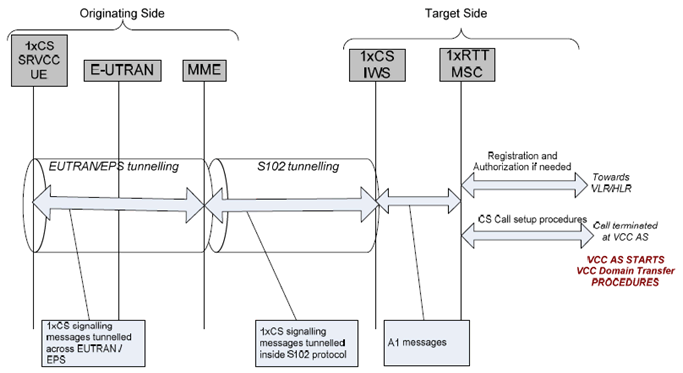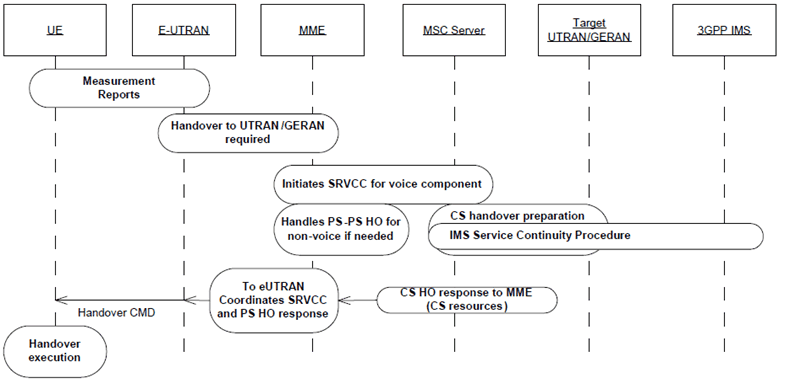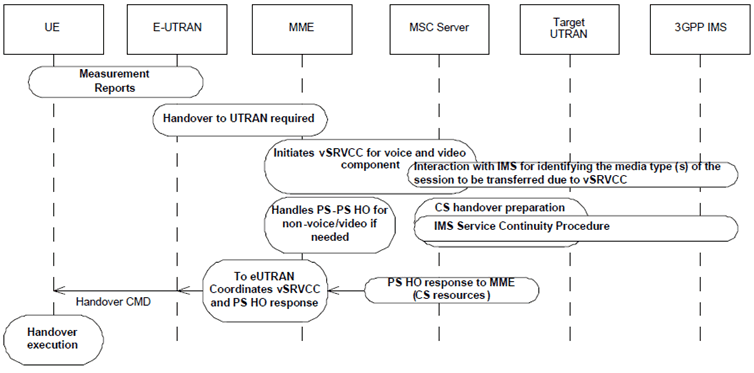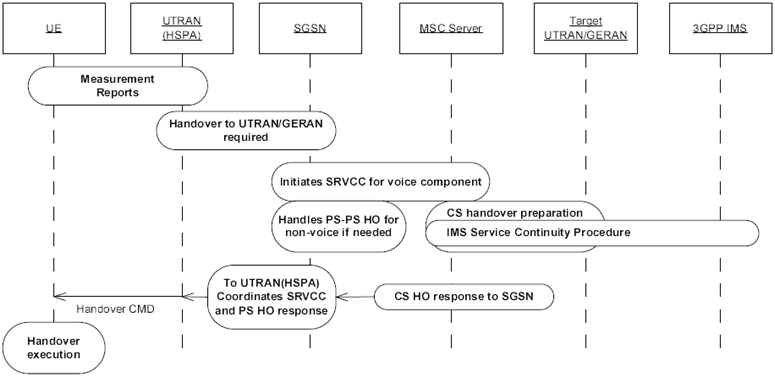Content for TS 23.216 Word version: 18.0.0
4.2 Concepts
4.2.1 E-UTRAN to 3GPP2 1xCS SRVCC
4.2.2 E-UTRAN to 3GPP UTRAN/GERAN SRVCC
4.2.2a E-UTRAN to 3GPP UTRAN vSRVCC
4.2.3 UTRAN (HSPA) to 3GPP UTRAN/GERAN SRVCC
...
...
4.2 Concepts p. 13
4.2.1 E-UTRAN to 3GPP2 1xCS SRVCC p. 13
For SRVCC-capable UEs, the call is always anchored at the VCC AS in the 3GPP2's IMS. The 3GPP2 1xCS IWS enables a single radio UE to communicate in parallel both with the source system and the target system. From VCC perspective, this mechanism minimizes the voice gap by supporting the transport of signalling for establishment of the target CS access leg while the terminal is connected to the source PS access network.

Figure 4.2.1-1: Transport of 3GPP2 1xCS signalling messages for preparation of the CS access leg in the target system
(⇒ copy of original 3GPP image)
(⇒ copy of original 3GPP image)
The S102 reference point is used to convey 3GPP2 1xCS signalling messages between the MME and 3GPP2 1xCS IWS. These 1x CS signalling messages are actually exchanged between the UE and the 3GPP2 1xCS IWS, and S102 is only one link in the overall UE-1xCS IWS tunnelling path. On the remaining portion of the tunnelling path, the 3GPP2 1xCS signalling messages are encapsulated in E-UTRAN/EPS tunnelling messages (UE-MME).
4.2.2 E-UTRAN to 3GPP UTRAN/GERAN SRVCC p. 14
For facilitating session transfer (SRVCC) of the voice component to the CS domain, the IMS multimedia telephony sessions needs to be anchored in the IMS.
For SRVCC from E-UTRAN to UTRAN/GERAN, MME first receives the handover request from E-UTRAN with the indication that this is for SRVCC handling, and then triggers the SRVCC procedure with the MSC Server enhanced for SRVCC via the Sv reference point if MME has STN-SR information for this UE. If SRVCC with priority is supported, based on the ARP associated with the EPS bearer used for IMS signalling, the MME sets the priority indication appropriately toward the MSC Server. MME aware of which EPS bearer is used for IMS signalling based on local configuration. MSC Server enhanced for SRVCC then initiates the session transfer procedure to IMS and coordinates it with the CS handover procedure to the target cell. If SRVCC with priority is supported, IMS session transfer procedure and the CS handover procedure are performed with priority handling per the priority indication received from MME. MSC Server enhanced for SRVCC then sends PS-CS handover Response to MME, which includes the necessary CS HO command information for the UE to access the UTRAN/GERAN.
Handling of any non-voice PS bearer is done by the PS bearer splitting function in the MME. MME starts the handover of non-voice PS bearer during SRVCC procedure based on the information received from E-UTRAN. The handover of non-voice PS bearer(s), if performed, is done as according to Inter RAT handover procedure as defined in TS 23.401. The MME is responsible to coordinate the Forward Relocation Response from PS-PS handover procedure and the SRVCC PS to CS Response.

Figure 4.2.2-1: Overall high level concepts for SRVCC from E-UTRAN to UTRAN/GERAN
(⇒ copy of original 3GPP image)
(⇒ copy of original 3GPP image)
4.2.2a E-UTRAN to 3GPP UTRAN vSRVCC |R11| p. 14
For facilitating session transfer of the voice and video components to the CS domain, the IMS multimedia telephony sessions needs to be anchored in the IMS.
For vSRVCC, the UE uses one voice and one video media component over the associated QCI=1 and vSRVCC marked PS bearers for bearer identification reasons. The MME first receives the handover request from E-UTRAN. It then triggers the vSRVCC procedure with the MSC Server enhanced for vSRVCC via the Sv reference point with vSRVCC related information. MSC Server enhanced for vSRVCC then interacts with IMS and initiates the session transfer procedure to IMS and coordinates it with the CS handover procedure to the target cell. If SRVCC with priority is supported, IMS session transfer procedure and the CS handover procedure are performed with priority handling according to the priority indication received from MME.
MSC Server performs SRVCC procedure if the current active session is voice only. MSC Server enhanced for vSRVCC then sends PS-CS Handover Response to MME, which includes the necessary CS HO command information for the UE to access the UTRAN. If the target cell is GERAN, MME only triggers SRVCC (i.e. only the voice component of the Video Call is transferred using the SRVCC procedure).
If SCC AS indicates current active session is voice and video, the MSC Server requests UTRAN radio resources for BS30 bearer and continues with the vSRVCC procedure. The BS30 bearer is a 64 kbps bearer for multimedia as defined in clause 3.1.2.1.3 of TS 22.002.If the BS30 bearer reservation was unsuccessful, then vSRVCC procedure is considered failed and appropriate rejection cause is given back to E-UTRAN.
Handling of any non QCI=1 and vSRVCC marked PS bearer is done by the PS bearer splitting function in the MME. MME starts the handover of non QCI=1 and vSRVCC marked PS bearer during vSRVCC procedure based on the information received from E-UTRAN. The handover of non QCI=1 and vSRVCC marked PS bearer(s), if performed, is done as according to Inter RAT handover procedure, as defined in TS 23.401. The MME is responsible to coordinate the Forward Relocation Response from PS-PS handover procedure and the vSRVCC PS to CS Response.
When the UE receives the HO Command indicating a TS 11 or BS30 bearer, it knows whether it should start the CS 3G-324M video codec negotiation or SRVCC.

Figure 4.2.2a-1: Overall high level concepts for vSRVCC from E-UTRAN to UTRAN
(⇒ copy of original 3GPP image)
(⇒ copy of original 3GPP image)
4.2.3 UTRAN (HSPA) to 3GPP UTRAN/GERAN SRVCC p. 15
For facilitating session transfer (SRVCC) of the voice component to the CS domain, the IMS multimedia telephony sessions needs to be anchored in the IMS.
For SRVCC from UTRAN (HSPA) to UTRAN/GERAN, SGSN first receives the handover request from UTRAN (HSPA) with the indication that this is for SRVCC handling, and then triggers the SRVCC procedure with the MSC Server enhanced for SRVCC via the Sv if SGSN has STN-SR information for this UE. MSC Server enhanced for SRVCC then initiates the session transfer procedure to IMS and coordinates it with the CS handover procedure to the target cell. MSC Server enhanced for SRVCC then sends PS-CS handover Response to SGSN, which includes the necessary CS HO command information for the UE to access the UTRAN/GERAN.
Handling of any non-voice PS bearer is done by the PS bearer splitting function in the SGSN. SGSN starts the handover of non-voice PS bearer during SRVCC procedure based on the information received from UTRAN (HSPA). The handover of non-voice PS bearer(s), if performed, is done as according to Inter/Intra RAT handover procedure as defined in TS 23.060 and TS 25.413. The SGSN is responsible to coordinate the Forward Relocation Response from PS-PS handover procedure and the SRVCC PS to CS Response.

Figure 4.2.3-1: Overall high level concepts for SRVCC from UTRAN (HSPA) to UTRAN/GERAN
(⇒ copy of original 3GPP image)
(⇒ copy of original 3GPP image)